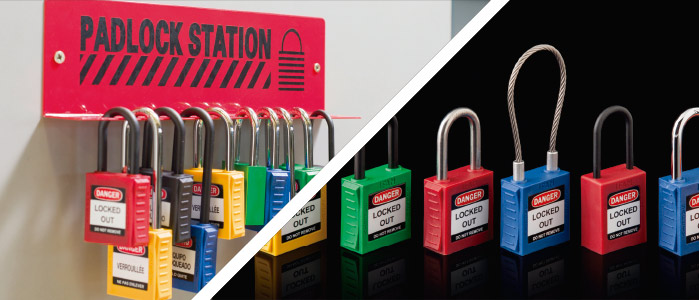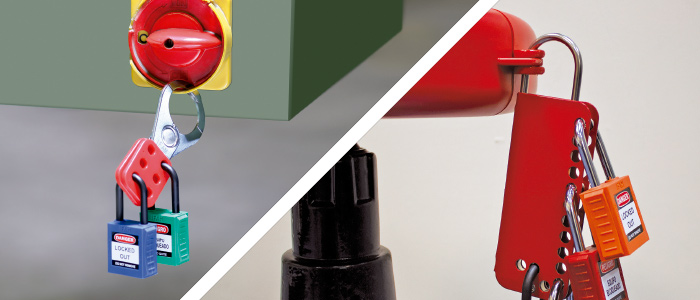What are lockout-tagout (LOTO) padlocks?
Padlocks are an intermediate element that is essential when locking energy sources for a machine or piece of equipment according to lockout-tagout (LOTO) protocols for industrial occupational safety. Why do we refer to them as an intermediate element? They are located in the middle of a sequence that begins by placing the main locking device – according to the energy source to be blocked – and a tag which indicates who is authorised to carry out any repair or maintenance work on the locked out machine or equipment.
These locking devices by their very nature – whether used for valves, electrical or pneumatic equipment, gas components, etc. – do not lock such items themselves, and they need one or several padlocks in order to do so. In this post we will examine what types of LOTO padlocks exist and what they are used for.
OSHA compliant products
We explained in previous blog post on OSHA lockout-tagout regulations, that LOTO products must meet with the following three requirements:
• Be clearly identifiable. This requirement is met by using bright colours that make these devices visible from a distance, as a safety measure in the area where inspection and maintenance work will be carried out on the machine.
• Only be used to control energy sources. These kinds of padlocks do not need to have high-security systems. They simply need to be able to close the main locking devices while the aforementioned inspection and maintenance takes place. In other words, they are not designed to protect machinery or equipment from theft.
• They should be durable, resistant, and easy to install. In this case we are referring to resistance to ultraviolet rays, chemical agents, high temperatures, electrical conduction, etc. which the equipment or machinery being locked out generates.
The importance of shackle materials for LOTO padlocks
The body of all LOTO padlocks is very similar with regards to the third requirement we discussed in the previous section. Therefore, LOTO padlocks have an ABS resin cover which is resistant to UV radiation, highly flammable environments, etc. The differentiating factor for these padlocks is the shackle material. The main shackle materials used for LOTO padlocks available on the market are:
• Chrome steel. Used for machinery or equipment where there is no risk of electrical contact.
• Stainless steel. Can be used for machinery maintenance where a dielectric model is not required, and also provides the padlock with additional resistance in industrial environments with high humidity and salinity levels. They are also suitable for outdoor use.
• Plastic resin. Used to prevent workers from any possible electrical contact that they could suffer during maintenance and repair work.
Normal, long, extra-long shackle…
Another aspect to consider when dealing with types of LOTO padlocks is the shackle length. Padlocks are available with normal, long, extra-long and even flexible cable shackles. Where does this requirement come from? It is basically down to the existing space in the work area, i.e. the area in which we can operate. If there is only a very narrow gap in which the padlock can close the main locking device, then padlocks with long or extra-long shackles are very useful as they can be put in place a lot more comfortably.
Colours: a matter of visibility and organisation
One of the most striking aspects of LOTO padlocks is without a doubt the bright colours. The IFAM range of LOTO padlocks includes models in red, green, blue, yellow, orange…
As noted, these bright colours guarantee the padlock visibility. They help to warn that the machinery and equipment has been locked out for repair or inspection, together with the main locking devices and the LOTO tags which also come in bright colours. They therefore prevent other workers from accidentally starting up the equipment while it is being worked on.
The LOTO padlock colours are also used to mark out access areas for the workers responsible for the repair and inspection work. This happens when different teams are working on a large machine with various locked out points, or on various machines at the same time. A padlock colour can also be assigned to each team member, so that one member of the team locks the machinery with yellow padlocks, another uses blue, etc.
LOTO padlock keys
LOTO padlocks are opened and closed with a standard flat key. As they are not designed to prevent theft, the lock does not require security pins. They do, on the other hand, include a security mechanism that retains the key in the lock when the padlock is open. This prevents the padlock from being closed without a key, forcing the worker in charge of the padlock to close it.
Another interesting aspect regarding the keys is that LOTO padlocks can be supplied keyed alike, or even with a master key, in addition to standard LOTO padlocks with different keys.
Having the same key is useful when a worker needs to handle numerous padlocks in a particular facility. However, it is important to note that according to OSHA regulations, a single set of padlocks with the same key cannot be distributed among different workers, as each worker must be responsible for their own padlocks.
In addition, master keys are ideal when dealing with large teams that work on a significant number of machines with multiple locking points. By using master keys, team managers can remove any padlock if necessary. The team managers are also responsible for storing the master keys in a place which only they can access.



